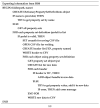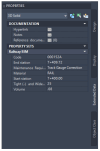Integration of Accelerometers and Machine Learning with BIM for Railway Tight- and Wide-Gauge Detection
- PMID: 40218510
- PMCID: PMC11990952
- DOI: 10.3390/s25071998
Integration of Accelerometers and Machine Learning with BIM for Railway Tight- and Wide-Gauge Detection
Abstract
Railway tight and wide gauges are critical factors affecting the safety and reliability of railway systems. Undetected tight and wide gauges can lead to derailments, posing significant risks to operations and passenger safety. This study explores a novel approach to detecting railway tight and wide gauges by integrating accelerometer data, machine-learning techniques, and building information modeling (BIM). Accelerometers installed on axle boxes provide real-time dynamic data, capturing anomalies indicative of tight and wide gauges. These data are processed and analyzed using supervised machine-learning algorithms to classify and predict potential tight- and wide-gauge events. The integration with BIM offers a spatial and temporal framework, enhancing the visualization and contextualization of detected issues. BIM's capabilities allow for the precise mapping of tight- and wide-gauge locations, streamlining maintenance workflows and resource allocation. Results demonstrate high accuracy in detecting and predicting tight and wide gauges, emphasizing the reliability of machine-learning models when coupled with accelerometer data. This research contributes to railway maintenance practices by providing an automated, data-driven methodology that enhances the proactive identification of tight and wide gauges, reducing the risk of derailments and maintenance costs. Additionally, the integration of machine learning and BIM highlights the potential for comprehensive digital solutions in railway asset management.
Keywords: accelerometer data; building information modeling; digital asset management; machine learning; railway maintenance; tight and wide gauge.
Conflict of interest statement
The authors declare no conflicts of interest.
Figures
















Similar articles
-
Digital twins for managing railway maintenance and resilience.Open Res Eur. 2021 Nov 1;1:91. doi: 10.12688/openreseurope.13806.2. eCollection 2021. Open Res Eur. 2021. PMID: 37645213 Free PMC article.
-
Integration of Railway Bridge Structural Health Monitoring into the Internet of Things with a Digital Twin: A Case Study.Sensors (Basel). 2024 Mar 26;24(7):2115. doi: 10.3390/s24072115. Sensors (Basel). 2024. PMID: 38610327 Free PMC article.
-
Digital Twins for Managing Railway Bridge Maintenance, Resilience, and Climate Change Adaptation.Sensors (Basel). 2022 Dec 26;23(1):252. doi: 10.3390/s23010252. Sensors (Basel). 2022. PMID: 36616851 Free PMC article.
-
A Survey on Data-Driven Predictive Maintenance for the Railway Industry.Sensors (Basel). 2021 Aug 26;21(17):5739. doi: 10.3390/s21175739. Sensors (Basel). 2021. PMID: 34502630 Free PMC article. Review.
-
A Review on Technologies for Localisation and Navigation in Autonomous Railway Maintenance Systems.Sensors (Basel). 2022 May 31;22(11):4185. doi: 10.3390/s22114185. Sensors (Basel). 2022. PMID: 35684804 Free PMC article. Review.
Cited by
-
Numerical simulations and experimental analysis of high-speed turnout rails wear models.Sci Rep. 2025 Jul 2;15(1):22680. doi: 10.1038/s41598-025-08065-4. Sci Rep. 2025. PMID: 40595202 Free PMC article.
-
Visualization Monitoring and Safety Evaluation of Turnout Wheel-Rail Forces Based on BIM for Sustainable Railway Management.Sensors (Basel). 2025 Jul 10;25(14):4294. doi: 10.3390/s25144294. Sensors (Basel). 2025. PMID: 40732422 Free PMC article.
References
-
- Shannon Rail . Track Gauge Book 3. Shannon Rail; Watford, UK: 2001.
-
- NSW Transport Rail Corporation . Tmc 203 Track Inspection. NSW Transport Rail Corporation; Sydney, Australia: 2019.
-
- Bocz P., Liegner N., Vinkó Á., Fischer S. Investigation of the Causes of Railway Track Gauge Narrowing. Vehicles. 2023;5:949–977. doi: 10.3390/vehicles5030052. - DOI
-
- Yilmazer M., Karakose M., Aydin I. Determination of Railway Track Gauge with Image Processing; Proceedings of the 2021 International Conference on Data Analytics for Business and Industry (ICDABI); Sakheer, Bahrain. 25–26 October 2021.
-
- Zhang G., Ma Z., Yuan J., Kang D., Yan D., Li J. Track gauge measurement based on wheel-rail lateral relative displacement. Opto-Electron. Eng. 2020;47:190252.
LinkOut - more resources
Full Text Sources

